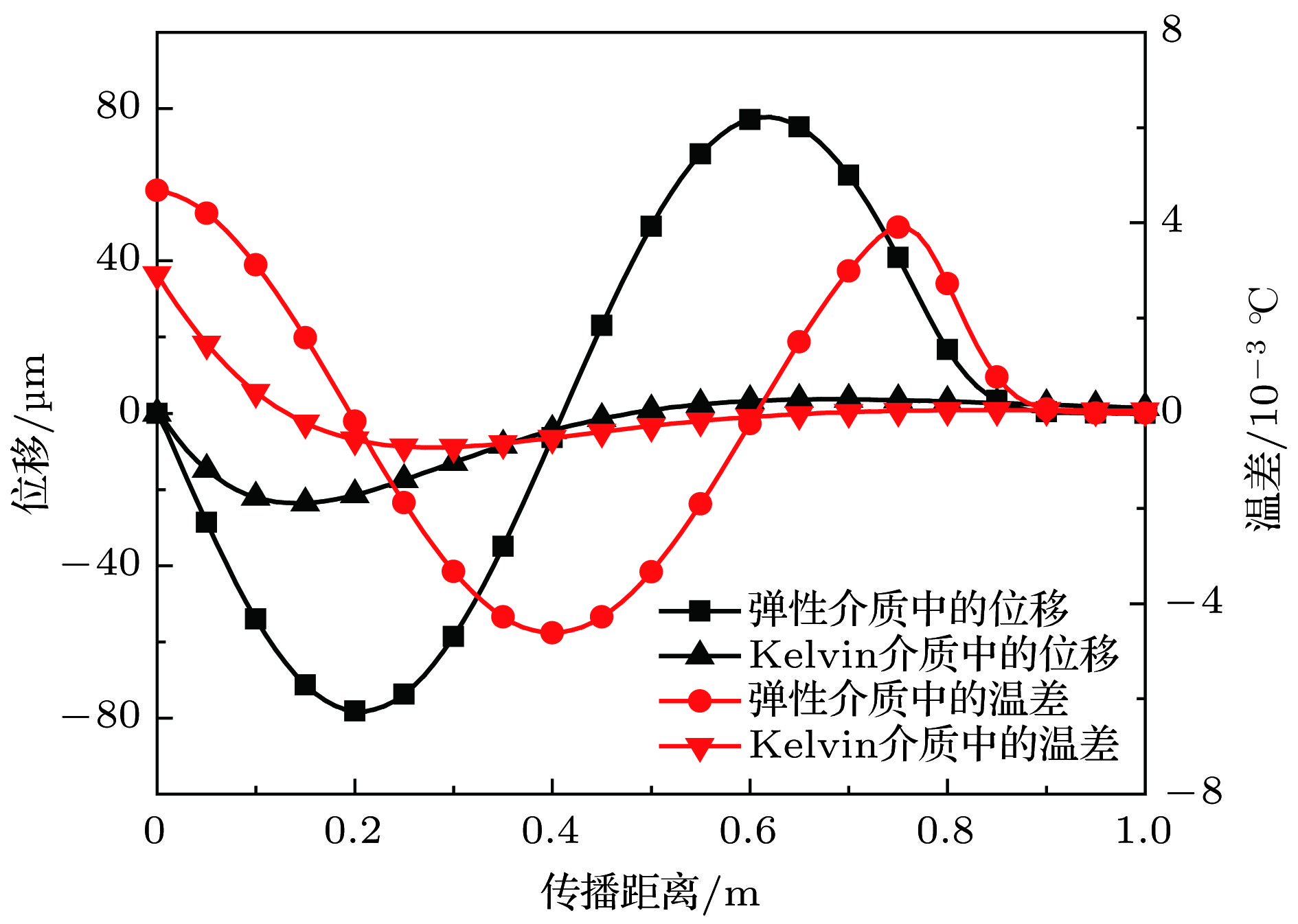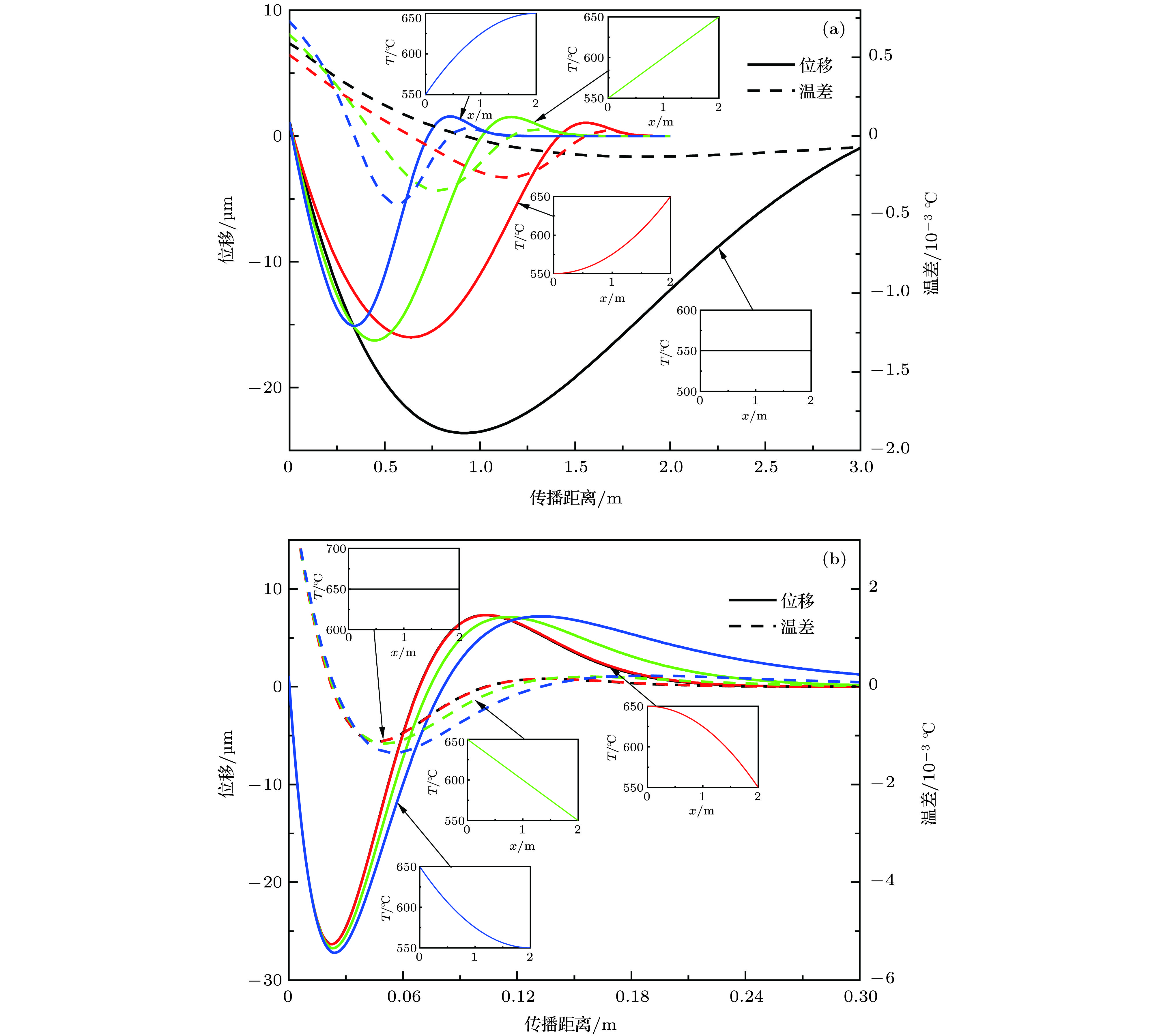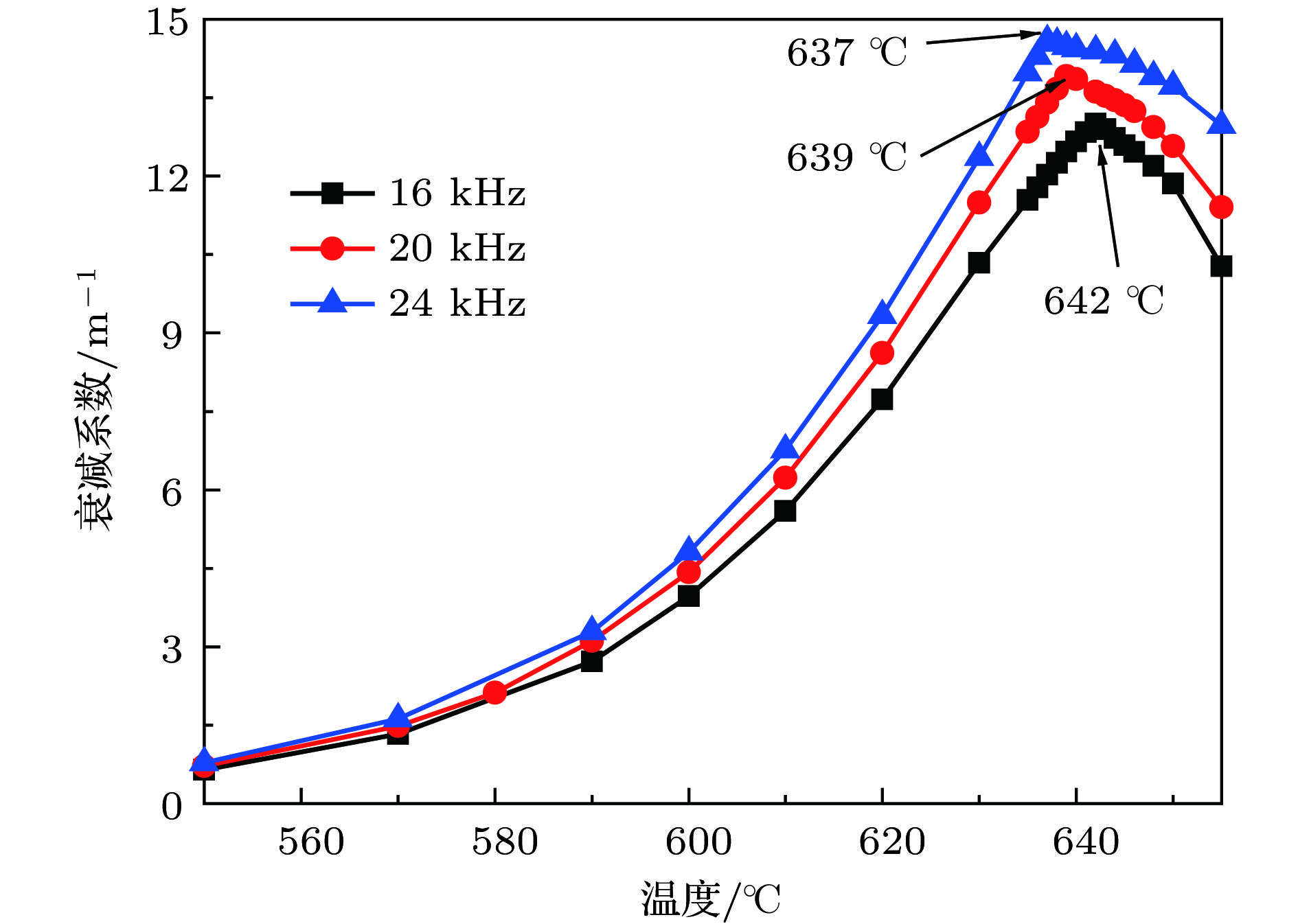-
机械波在金属凝固过程中传播的定量计算一直是一个难题, 主要原因就是在这个过程中的熔体结构非常复杂. 本研究考虑到熔体的变温、非均匀和粘弹性的特点, 采用Kelvin粘弹性介质模型, 建立了具有粘热损失特性的热粘弹性波动方程, 通过隐式有限差分方法对波动方程进行求解, 并以ZL203A合金熔体为研究对象, 探究了热粘弹波在变温非均匀介质中的传播规律. 结果表明: 热粘弹波从合金熔体的低温区向高温区传播时, 非均匀的温度场对波的传播有较大影响; 相反, 当波从合金熔体的高温区向低温区传播时, 非均匀的温度场对波的传播几乎没有影响. 热粘弹波在合金熔体中的衰减系数随频率的增大呈线性增大, 而随温度的升高先增大后减小, 在熔体的枝晶搭接温度附近达到最大值.The quantitative calculation of mechanical wave propagation in the solidification of metal is difficult because of the complicated structure of melt in the solidification process. In this study, the Kelvin model is used to describe the viscoelastic characteristics of alloy melt, and the thermoviscoelastic wave equations are established in conjunction with continuity equation, momentum equation, energy equation considering thermo-mechanical effect and constitutive equation considering thermal stress. The difference equation of thermoviscoelastic wave in the variable non-uniform temperature field is built by using the implicit finite difference method of second order in space and first order in time, and taking into account the variable temperature and non-uniformity of melt. The difference equation is solved numerically by taking the thermodynamic parameters of ZL203A alloy in solid-liquid region varying with temperature as calculation parameters, and the propagation law of thermoviscoelastic wave in the inhomogeneous alloy melt with varying temperature is obtained. By comparing the propagation law of the wave with same wavelength in elastic medium with that in viscoelastic medium, it is found that the thermoviscoelastic wave attenuates seriously, and the thermoelastic wave has no attenuation. The step of displacement of thermoviscoelastic wave will be smoothed rapidly during propagation. The comparison among propagations of thermoviscoelastic wave in homogeneous medium at different temperatures shows that the wavelength of thermoviscoelastic wave in high temperature melt is smaller and the attenuation is more serious than in low temperature melt. The propagation of thermoviscoelastic wave in inhomogeneous medium is equivalent to the propagation in layered medium with different impedance, which makes the attenuation more serious than in homogeneous medium. When the thermoviscoelastic wave propagates from the low temperature region to the high one, the distribution of inhomogeneous temperature field has a great influence on the propagation of wave. The smaller the slope of the temperature field at the incidence of the wave, the smaller the attenuation of the wave is, and the farther the propagation distance is, conversely, when the wave propagates from the high temperature region to the low one, the distribution of the inhomogeneous temperature field has little influence on the propagation of wave. The calculation results of attenuation coefficients of thermoviscoelastic wave with different frequencies at different temperatures show that the attenuation coefficients of thermoviscoelastic waves in alloy melt are bigger in the high temperature medium than in the low temperature medium, and it increases linearly with the frequency increasing. The attenuation coefficient first increases and then decreases with temperature increasing, and reaches a maximum value at the coherency temperature.
-
Keywords:
- thermoviscoelastic wave /
- numerical simulation /
- alloy melt /
- Kelvin medium /
- attenuation coefficient
[1] Guo F, Luo P, Qiu B, Li K 2008 Met. Mat. Metall. Eng. 1 015
[2] Kotadia H R, Qian M, Eskin D G, Das A 2017 Mater. Design 6 65
[3] Chen R R, Zheng D S, Guo J J, Fu H Z 2016 Mater. Sci. Eng. A 653 23
 Google Scholar
Google Scholar
[4] Eskin G I, Eskin D G 2014 Ultrasonic Treatment of Light Alloy Melts (Boca Raton: CRC Press)
[5] Wang R J, Wu S P, Chen W 2018 T. Nonferr. Metal. Soc. 28 1514
 Google Scholar
Google Scholar
[6] Zhang M, Li X, Li Z H, Xu X 2011 Special Casting and Nonferrous Alloys 2 034
[7] Wu S P, Wang R J, Chen W 2017 Acta Metall. Sin. 54 247
[8] Wang R J, Wu S P, Chen W 2019 Simulation 95 3
 Google Scholar
Google Scholar
[9] Kong W, Cang D 2012 Simulation 88 694
 Google Scholar
Google Scholar
[10] Jiang R P, Li X Q, Ju Z Y, Zhang M 2014 J. South China Univ. Techno.: Nat. Sci. Ed. 4 014
[11] Shao Z W, Le Q, Zhang Z Q, Cui J Z 2011 T. Nonferr. Metal. Soc. 21 2476
 Google Scholar
Google Scholar
[12] Mccarthy M F, Moodie T B, Sawatzky R P 1988 Q. Appl. Math. 46 539
 Google Scholar
Google Scholar
[13] Nowinski J L, Boley B 1980 J. Appl .Mech 47
[14] Bruno B A, Jerome H W 2012 Theory of Thermal Stresses [https://www.ebookmall.com/ebook/theory-of-thermal-stresses/bruno-a-boley/9780486695792]
[15] 范绪箕, 陈国光 1982 力学进展 12 339
Fan X J, Chen G G 1982 Adv. Mech. 12 339
[16] Takeuti Y, Tanigawa Y 1979 Int. J. Numer. Meth. Eng. 14 987
 Google Scholar
Google Scholar
[17] 刘驰, 李庆春 1988 铸造 9 28
Liu C, Li Q C 1988 Foundry 9 28
[18] Fraizier E , Nadal M H , Oltra R 2002 Ultrasonics 40 543
 Google Scholar
Google Scholar
[19] Jarzynski J 1963 Proc. Phys. Soc. 81 745
 Google Scholar
Google Scholar
[20] Bansal R 2002 J. Phys. C: Solid State Phys. 6 1204
[21] 牛滨华, 孙春岩 2007 半无限空间各向同性黏弹性介质与地震波传播(北京: 地质出版社) 第107页
Niu B H, Sun C Y 2007 Half-space homogeneous isotropic viscoelastic medium and seismic wave propagation (Beijing: Geological Publishing House) p107 (in Chinese)
[22] Li J W, Momono T, Ying F U, Jia Z, Yu Y T 2007 T. Nonferr. Metal. Soc. 17 691
 Google Scholar
Google Scholar
[23] Lavender J D 1972 Non-Destructive Testing 52 107
[24] Magnin B, Maenner L, Katgerman Laurens, Engler S 1996 Mater. Sci. Forum 217 1209
[25] Sivkov G, Yagodin D, Kofanov S, Gornov O, Volodin S, Bykov V, Dahlborg U 2007 J. Non-Cryst. Solids 353 3274
 Google Scholar
Google Scholar
-
图 6 热粘弹波在不同的非均匀温度场中的位移和温差的分布 (a)波从低温区域向高温区域传播;(b)波从高温区域向低温区域传播
Fig. 6. Distribution of displacement and temperature difference of thermoviscoelastic wave in different inhomogeneous temperature field: (a) Propagation from low temperature region to high temperature region; (b) propagation from high temperature region to low temperature region.
-
[1] Guo F, Luo P, Qiu B, Li K 2008 Met. Mat. Metall. Eng. 1 015
[2] Kotadia H R, Qian M, Eskin D G, Das A 2017 Mater. Design 6 65
[3] Chen R R, Zheng D S, Guo J J, Fu H Z 2016 Mater. Sci. Eng. A 653 23
 Google Scholar
Google Scholar
[4] Eskin G I, Eskin D G 2014 Ultrasonic Treatment of Light Alloy Melts (Boca Raton: CRC Press)
[5] Wang R J, Wu S P, Chen W 2018 T. Nonferr. Metal. Soc. 28 1514
 Google Scholar
Google Scholar
[6] Zhang M, Li X, Li Z H, Xu X 2011 Special Casting and Nonferrous Alloys 2 034
[7] Wu S P, Wang R J, Chen W 2017 Acta Metall. Sin. 54 247
[8] Wang R J, Wu S P, Chen W 2019 Simulation 95 3
 Google Scholar
Google Scholar
[9] Kong W, Cang D 2012 Simulation 88 694
 Google Scholar
Google Scholar
[10] Jiang R P, Li X Q, Ju Z Y, Zhang M 2014 J. South China Univ. Techno.: Nat. Sci. Ed. 4 014
[11] Shao Z W, Le Q, Zhang Z Q, Cui J Z 2011 T. Nonferr. Metal. Soc. 21 2476
 Google Scholar
Google Scholar
[12] Mccarthy M F, Moodie T B, Sawatzky R P 1988 Q. Appl. Math. 46 539
 Google Scholar
Google Scholar
[13] Nowinski J L, Boley B 1980 J. Appl .Mech 47
[14] Bruno B A, Jerome H W 2012 Theory of Thermal Stresses [https://www.ebookmall.com/ebook/theory-of-thermal-stresses/bruno-a-boley/9780486695792]
[15] 范绪箕, 陈国光 1982 力学进展 12 339
Fan X J, Chen G G 1982 Adv. Mech. 12 339
[16] Takeuti Y, Tanigawa Y 1979 Int. J. Numer. Meth. Eng. 14 987
 Google Scholar
Google Scholar
[17] 刘驰, 李庆春 1988 铸造 9 28
Liu C, Li Q C 1988 Foundry 9 28
[18] Fraizier E , Nadal M H , Oltra R 2002 Ultrasonics 40 543
 Google Scholar
Google Scholar
[19] Jarzynski J 1963 Proc. Phys. Soc. 81 745
 Google Scholar
Google Scholar
[20] Bansal R 2002 J. Phys. C: Solid State Phys. 6 1204
[21] 牛滨华, 孙春岩 2007 半无限空间各向同性黏弹性介质与地震波传播(北京: 地质出版社) 第107页
Niu B H, Sun C Y 2007 Half-space homogeneous isotropic viscoelastic medium and seismic wave propagation (Beijing: Geological Publishing House) p107 (in Chinese)
[22] Li J W, Momono T, Ying F U, Jia Z, Yu Y T 2007 T. Nonferr. Metal. Soc. 17 691
 Google Scholar
Google Scholar
[23] Lavender J D 1972 Non-Destructive Testing 52 107
[24] Magnin B, Maenner L, Katgerman Laurens, Engler S 1996 Mater. Sci. Forum 217 1209
[25] Sivkov G, Yagodin D, Kofanov S, Gornov O, Volodin S, Bykov V, Dahlborg U 2007 J. Non-Cryst. Solids 353 3274
 Google Scholar
Google Scholar
计量
- 文章访问数: 8351
- PDF下载量: 43
- 被引次数: 0














 下载:
下载:







